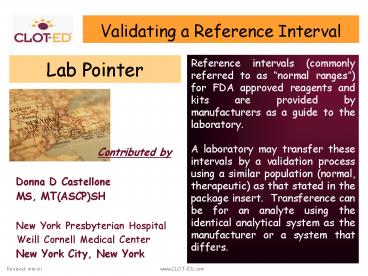Validating a Reference Interval - PowerPoint PPT Presentation
1 / 5
Title:
Validating a Reference Interval
Description:
Reference intervals (commonly referred to as 'normal ranges') for FDA approved ... DO NOT use Emergency Room or Pre-operative patients ... – PowerPoint PPT presentation
Number of Views:82
Avg rating:3.0/5.0
Title: Validating a Reference Interval
1
Validating a Reference Interval
- Reference intervals (commonly referred to as
normal ranges) for FDA approved reagents and
kits are provided by manufacturers as a guide to
the laboratory. - A laboratory may transfer these intervals by a
validation process using a similar population
(normal, therapeutic) as that stated in the
package insert. Transference can be for an
analyte using the identical analytical system as
the manufacturer or a system that differs.
Lab Pointer
Contributed by Donna D Castellone MS,
MT(ASCP)SH New York Presbyterian Hospital Weill
Cornell Medical Center New York City, New York
Revised mmiiii
www.CLOT-ED.com
2
Validating a Reference Interval
- Importance
- Reference intervals that are health associated
are used for interpreting patient test results
(normal vs abnormal) - Reference intervals established for therapeutics
are used to monitor patient treatment, for
example, warfarin or heparin therapy - Mean of reference interval for Prothrombin Time
is used for calculating the INR
Lab Pointer
Revised mmiiii
www.CLOT-ED.com
3
Validating a Reference Interval
- NCCLS C28-A2 (2000)
- Laboratories may transfer (use) a reference
interval prepared by a manufacturer if the
laboratory performs validation studies. This is
considerably easier to do than actually setting a
reference interval for which NCCLS recommends a
minimum of 120 reference subjects. The
validation process must be as consistent as
possible with pre-analytical and analytical
conditions encountered by the manufacturer.
Should demographics of laboratory and
manufacturer populations differ, then
transference can not be used.
Lab Pointer
- NCCLS H21-A4 (2003)
- Establishing a reference interval for coagulation
assays should occur in the following situations - For a new analytical method
- When a lot number of reagent is changed for an
existing analytical method - Change in instrumentation (old to new instrument)
- Change in blood collection system
- Annually
Revised mmiiii
www.CLOT-ED.com
4
Validating a Reference Interval
- Validation studies for transference require steps
similar to those used for establishing a
reference interval. Sections 4 5 of NCCLS
C28-A2 outline these steps in detail. It is
acceptable to use a minimum of 20 reference
individuals, the selection of whom is critical.
A questionnaire can be used in order to exclude
or partition individuals (a priori sampling). In
a posteriori sampling, exclusion and partitioning
occur after sampling and testing have been
performed. The reference interval is acceptable
if no more than 2 of the 20 values (10) fall
outside the manufacturers limits.
Lab Pointer
Questionnaire
Revised mmiiii
www.CLOT-ED.com
M Ledford-Kraemer
5
Validating a Reference Interval
- Be sure that your laboratorys reference interval
reflects your patient population - DO NOT use Emergency Room or Pre-operative
patients - These patients may have acute phase reactants
(proteins that are elevated in times of stress,
infection or inflammation such as FVIII, VWF, and
Fibrinogen that will falsely shorten a PT APTT) - Use an equal distribution of males and females
- Run over a period of time to introduce
intra-laboratory variables and reduce bias
Lab Pointer
Remember that validating reference intervals is
one of the most important coagulation tasks you
will perform
Revised mmiiii
www.CLOT-ED.com































